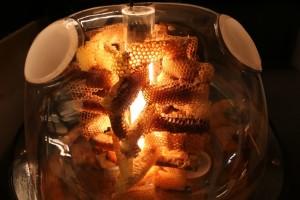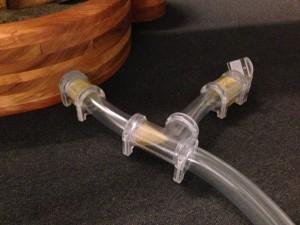 “Bees are the world’s first 3D printers,” says Jennifer Berry. An ecologist, landscape designer, artist, teacher, Berry is the founder of Berry Design Ecology, her personal consulting practice. Her work combines her backgrounds in art and biology, and has resulted in some ingenious designs and inventions, including an incredible 3D printer that she designed and constructed herself, using bees as her inspiration.
“Bees are the world’s first 3D printers,” says Jennifer Berry. An ecologist, landscape designer, artist, teacher, Berry is the founder of Berry Design Ecology, her personal consulting practice. Her work combines her backgrounds in art and biology, and has resulted in some ingenious designs and inventions, including an incredible 3D printer that she designed and constructed herself, using bees as her inspiration.
We’ve written about biomimicry before; the principle has been used in most industries to design some of our most successful products. Nature is smart, often smarter than humans, in fact, when it comes to preserving health and creating resiliency. Few people realize just how many of the man-made things we depend on have been inspired by insects, or plants, or birds. Although 3D printers weren’t inspired by bees, per se, Berry certainly isn’t the first to notice that they do naturally what we as humans have put billions of dollars into developing as a technology.
 Berry, who counts beekeeping as one of her myriad interests, used to work as an artist in residence at the Autodesk Pier 9 Artists in Residence Program in San Francisco. While there, she began developing a 3D printer that actually worked with bees to create biodegradable, sustainable and even edible printed art. The B-Code Biopolymer Printer is both a printer and a beehive, and Berry has documented its creation on Instructables.
Berry, who counts beekeeping as one of her myriad interests, used to work as an artist in residence at the Autodesk Pier 9 Artists in Residence Program in San Francisco. While there, she began developing a 3D printer that actually worked with bees to create biodegradable, sustainable and even edible printed art. The B-Code Biopolymer Printer is both a printer and a beehive, and Berry has documented its creation on Instructables.
“I first became involved with Additive Manufacturing some ten years ago in the prototyping industry,” Berry explains. “At the time we called it ‘growing’ a part, which is a great way to convey this concept, so similar to how nature builds its things. It was the idea of growing parts that became the basis for my development towards a biological 3D printer…With the B-code printer, a biopolymer is extruded from a nozzle, in this case the bee’s mouth, and is ‘drawn’ in a long thread, one layer deposited atop another and air cured. The extruded biopolymer is made of beeswax, a long-chain alcohol plastic similar to ethylene, formed of esters of fatty acids secreted from the glands of young adult bees.”
 She named the printer “B-Code” because, as she explains, the logic by which bees operate is actually very similar to the logic used in binary and other computer coding. Knowledge of the bees’ code was what enabled her to design the printer, which the bees would actually live inside. Berry created several prototypes, ending up with a clear, domelike enclosure, lit with LED light tubing. The completed printer looks like a work of art in itself, but the final artwork was completed by the bees, which Berry introduced into the printer as their new, temporary home.
She named the printer “B-Code” because, as she explains, the logic by which bees operate is actually very similar to the logic used in binary and other computer coding. Knowledge of the bees’ code was what enabled her to design the printer, which the bees would actually live inside. Berry created several prototypes, ending up with a clear, domelike enclosure, lit with LED light tubing. The completed printer looks like a work of art in itself, but the final artwork was completed by the bees, which Berry introduced into the printer as their new, temporary home.
It’s important to note that no bees were harmed in the making of the printer, and when the “print job” was finished, the bees exited naturally and flew off to find another hive. A tremendous amount of work went into making the hive/printer bee-friendly, and Berry carefully details it all in her Instructable, but in short, the bees go about their business inside the enclosure, building a delicate, spiraling honeycomb sculpture – a completely natural 3D print, which Berry then incorporated into her own work, referring to it as collaborative art.
I’ll be honest – what Berry has done blows my mind, and I know I could never even begin to try reproducing what she made. If you’d like to try, though, take a look at the full Instructable, which explains it all much better than I can, and perhaps you too can collaborate with bees to create beautiful, ecological sculpture. Discuss this amazing creation in the 3D Printer Beehive forum over at 3DPB.com.
Subscribe to Our Email Newsletter
Stay up-to-date on all the latest news from the 3D printing industry and receive information and offers from third party vendors.
You May Also Like
Gorilla Sports GE’s First 3D Printed Titanium Cast
How do you help a gorilla with a broken arm? Sounds like the start of a bad joke a zookeeper might tell, but it’s an actual dilemma recently faced by...
Nylon 3D Printed Parts Made More Functional with Coatings & Colors
Parts 3D printed from polyamide (PA, Nylon) 12 using powder bed fusion (PBF) are a mainstay in the additive manufacturing (AM) industry. While post-finishing processes have improved the porosity of...
$25M to Back Sintavia’s Largest Expansion of Metal 3D Printing Capacity Since 2019
Sintavia, the digital manufacturing company specializing in mission-critical parts for strategic sectors, announced a $25 million investment to increase its production capacity, the largest expansion to its operations since 2019....
Velo3D Initiates Public Offering in a Bid to Strengthen Financial Foundations and Drive Future Growth
Velo3D (NYSE: VLD) has been among a number of publicly traded 3D printing firms that have attempted to weather the current macroeconomic climate. After posting a challenging financial report for 2023,...






























